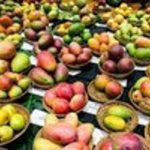The Agriculture Department, headed by the Minister of Agriculture, Senior Ratan Lal Nath, has put on a display of the mangoes grown in Tripura in the expansive orchard of the department for horticulture within the Nagicherra the region.
Three essential cultivars and hybrids such as Amrapali, Himsagar, Mallika along with other types from local sources are commercially grown in various regions of Tripura. “The space of Amrapali cultivation is significantly larger that Himsagar and Mallika and the agricultural communities of Tripura has a significant revenue from the cultivation of these kinds of mangoes” declared Ratan Lal Nath, the Agriculture Minister.
Minister told the press that when it comes to the productivity of south Tripura is the highest of all districts, as it produces 11,595 tons of mangoes can be produced on 2,272 acres of area . In Gomati district, the annual output is 8,134 tons spread over 1,595 acres of land. It is then followed by Sepahijala district, where the production per year is 5,355 tons spread over 1,052 acres of surface. In the west of Tripura there is a production that of 6,958 tonnes over 1,367 acres of the land.
Source: tripurainfo.com
